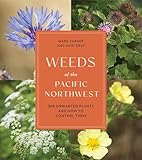“Weeds of the Pacific Northwest” may not sound like an exciting book. But look closer at the sub-title: “368 Unwanted Plants and How to Control Them.” Gardeners – these are OUR weeds! Time to get to know them, and how to eliminate them. Or just live with them.
Resembling an oversized field guide, photographer Mark Turner’s superb pictures make identifying your culprits quite easy, especially as he provides two or three images for each species. Turner honed his craft by illustrating two of the standard guides to our native plants: “Wildflowers of the Pacific Northwest” (published in 2006 with co-author Phyllis Gustafson) and “Trees and Shrubs of the Pacific Northwest” (2014 with Ellen Kuhlmann).
 Author Sami Gray had an important role in the third edition (2019) of “Gardening with Native Plants of the Pacific Northwest,” writing in the character of original author Art Kruckeberg for new additions and in organizing the photographs. She bring the same skill set in writing this book, clearly aimed at the small scale gardener.
Author Sami Gray had an important role in the third edition (2019) of “Gardening with Native Plants of the Pacific Northwest,” writing in the character of original author Art Kruckeberg for new additions and in organizing the photographs. She bring the same skill set in writing this book, clearly aimed at the small scale gardener.
This combination of talents has resulted in a book that is both an important reference work, and a fascinating look at the non-native plants that have established themselves in our region. A few natives that can overrun cultivated plantings are also considered.
An example is Equisetum arvense, the common horsetail. We learned that although this is native throughout most of the northern hemisphere, it is “so ubiquitous and so aggressive” these plants are “widely treated as weeds.”
With deep roots (to 20 feet!) it is very difficult, if not impossible, to eradicate – no surprise to gardeners dealing with this plant. The final advice: “Small patches may be discouraged, though probably not vanquished, by persistent pulling. Or you could move.”
How to get rid of other invaders? There isn’t a one size fits all answer. In the chapter “Out, Damned Weed,” Gray presents the many techniques and tools available, including a thoughtful discussion on both conventional and alterative herbicides. The conclusion? “Prevention is preferable to marathon weeding sessions on hands and knees. And if a few weeds survive, it’s not the end of the world.”
Reviewed by: Brian Thompson on August 15, 2024
Published in Garden Notes: Northwest Horticultural Society, Fall 2024
Update May 8, 2025: The Council on Botanical and Horticultural Libraries gave a 2025 Award of Excellence in Horticulture to “Weeds of the Pacific Northwest”